What is aural fullness - Study guides, Class notes & Summaries
Looking for the best study guides, study notes and summaries about What is aural fullness? On this page you'll find 95 study documents about What is aural fullness.
Page 2 out of 95 results
Sort by
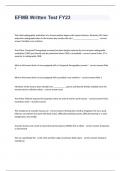
-
EFMB Written Test FY23 questions and answers graded A+ already passed
- Exam (elaborations) • 42 pages • 2023
-
Available in package deal
-
- $12.99
- + learn more
EFMB Written Test FY23The initial radiographic evaluation of a trauma patient begins with supine Anterior- Posterior (AP) chest and pelvis radiographs taken in the trauma bay usually with a(n) _______________________ - correct answer Portable x-ray machine. True/False: Computed Tomography scanning has been largely replaced by cervical spine radiographic evaluation (CSRE) and should only be performed when CSRE is unavailable - correct answer False, CT is superior to radiographic CSRE What i...
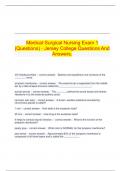
-
Medical-Surgical Nursing Exam 1 (Questions) - Jersey College Questions And Answers.
- Exam (elaborations) • 33 pages • 2024
-
- $11.99
- + learn more
Medical-Surgical Nursing Exam 1 (Questions) - Jersey College Questions And Answers. VIII Vestibucochlear - correct answer. Balance and equilibrium are functions of the ________ nerve. tympanic membrane - correct answer. The external ear is separated from the middle ear by a disk-shaped structure called the ________________________. auricle (pinna) - correct answer. The _______ collects the sound waves and directs vibrations in to the external auditory canal. cerume...

-
PAEA Pediatrics EOR Topics Questions and Answers Rated A+.
- Exam (elaborations) • 55 pages • 2023
- Available in package deal
-
- $12.99
- + learn more
PAEA Pediatrics EOR Topics Questions and Answers Rated A+. what is the MC conjunctivitis seen in children? what is the cause? source? viral conjunctivitis; Adenovirus; swimming pools Dx? preauricular lymphadenopathy, copious watery eye discharge, scanty mucoid discharge, usually unilateral with punctate staining on slit lamp examination; Tx? dx: viral conjunctivitis tx: supportive (cool compresses, artificial tears) +/- antihistamines for itching (Olopatadine) Dx? bilateral eye itching, te...
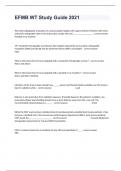
-
EFMB WT Study Guide 2021 Questions And Answers 100% Verified Complete Answers.
- Exam (elaborations) • 48 pages • 2024
-
- $16.99
- + learn more
The initial radiographic evaluation of a trauma patient begins with supine Anterior-Posterior (AP) chest and pelvis radiographs taken in the trauma bay usually with a(n) _________________. - correct answer Portable x-ray machine T/F: Computed Tomography scanning has been largely replaced by cervical spine radiographic evaluation (CSRE) and should only be performed when CSRE is unavailable. - correct answer ...
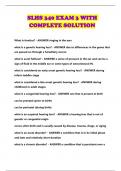
-
SLHS 340 EXAM 3 WITH COMPLETE SOLUTION
- Exam (elaborations) • 20 pages • 2024
- Available in package deal
-
- $9.99
- + learn more
SLHS 340 EXAM 3 WITH COMPLETE SOLUTION...
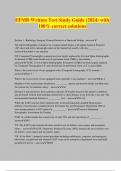
-
EFMB Written Test Study Guide (2024) with 100% correct solutions
- Exam (elaborations) • 40 pages • 2024
-
- $14.49
- + learn more
EFMB Written Test Study Guide (2024) with 100% correct solutions Section 1 - Radiology: Imaging Trauma Patients in a Deployed Setting - answer- The initial radiographic evaluation of a trauma patient begins with supine Anterior-Posterior (AP) chest and pelvis radiographs taken in the trauma bay usually with a(n) __________. - answerportable x-ray machine T/F: Computed Tomography scanning has been largely replaced by Cervical Spine Radiographic Evaluation (CSRE) and should only be performe...
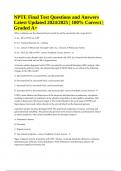
-
NPTE Final Test Questions and Answers Latest Updated 2024/2025 (100% Correct)
- Exam (elaborations) • 112 pages • 2024
-
- $15.49
- + learn more
NPTE Final Test Questions and Answers Latest Updated 2024/2025 (100% Correct) What conditions are the abnormal heart sounds S3 and S4 associated with, respectively? A. S3 = MI or HTN; S4 =CHF B. S3 = Tracheal Stenosis; S4 = Asthma C. S3 = closure of Mitral and Tricuspid Valves; S4 = Closure of Pulmonary Valves D. S3 = CHF; S4 =MI or HTN - answer Feedback Correct Answer - D S3 is heard in early diastole (after S2) and is associated with CHF. S4 is heard in late diastole (before S1) and is a...
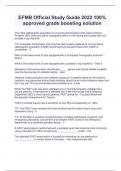
-
EFMB Official Study Guide 2022 100% approved grade boosting solution RATED A+ 2023|2024 LATEST UPDATE
- Exam (elaborations) • 30 pages • 2023
-
- $12.49
- + learn more
EFMB Official Study Guide 2022 100% approved grade boosting solution The initial radiographic evaluation of a trauma patient begins with supine Anterior- Posterior (AP) chest and pelvis radiographs taken in the trauma bay usually with a(n) - portable x-ray machine T/F: Computed Tomography scanning has been largely replaced by cervical spine radiographic evaluation (CSRE) and should only be performed when CSRE is unavailable. - F What is the lowest level of care equipped with a Computed T...
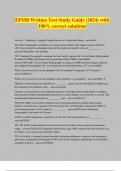
-
EFMB Written Test Study Guide (2024) with 100% correct solutions
- Exam (elaborations) • 40 pages • 2024
-
- $14.49
- + learn more
EFMB Written Test Study Guide (2024) with 100% correct solutions Section 1 - Radiology: Imaging Trauma Patients in a Deployed Setting - answer- The initial radiographic evaluation of a trauma patient begins with supine Anterior-Posterior (AP) chest and pelvis radiographs taken in the trauma bay usually with a(n) __________. - answerportable x-ray machine T/F: Computed Tomography scanning has been largely replaced by Cervical Spine Radiographic Evaluation (CSRE) and should only be performe...
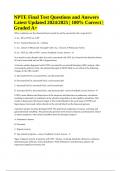
-
NPTE Final Test Questions and Answers Latest Updated 2024/2025 (100% Correct | Graded A+)
- Exam (elaborations) • 112 pages • 2024
-
- $17.99
- + learn more
NPTE Final Test Questions and Answers Latest Updated 2024/2025 (100% Correct | Graded A+) What conditions are the abnormal heart sounds S3 and S4 associated with, respectively? A. S3 = MI or HTN; S4 =CHF B. S3 = Tracheal Stenosis; S4 = Asthma C. S3 = closure of Mitral and Tricuspid Valves; S4 = Closure of Pulmonary Valves D. S3 = CHF; S4 =MI or HTN - answer Feedback Correct Answer - D S3 is heard in early diastole (after S2) and is associated with CHF. S4 is heard in late diastole (before ...

How did he do that? By selling his study resources on Stuvia. Try it yourself! Discover all about earning on Stuvia


